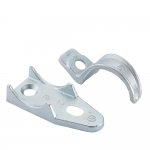Steel only, almost never die cast although I have used them.
Saw recently the cheaply made steel ones. You had to back the screw out to get it over the pipe then the screw would fall out. If you made it that far it would strip going back in with a small impact tool. Screw would just spin in the fitting. Saw that last summer.
The square drives never seemed to fit the bit either. Swapping bits and bit sizes did not help with that. Saw pallets of them. The bad ones had a regular brand name, came from a supply house, but were clearly stamped INDIA.


